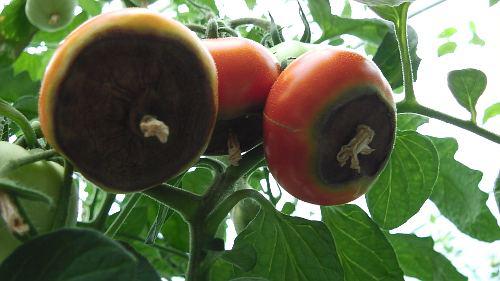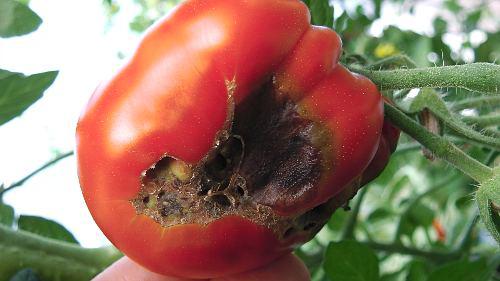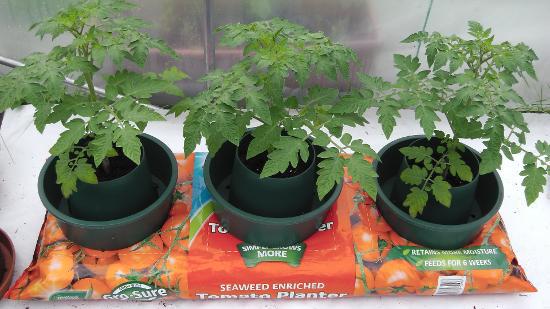This week we continue looking at Blossom End Rot & How To Avoid It and the reasons why Blossom End Rot (BER) appears on our tomatoes with suggestions on how to avoid it.

Nothing happens without transpiration
Transpiration is the loss of moisture from the leaves which allows moisture to be drawn back into a plant through the roots – in an unbroken chain.
The rate of transpiration or moisture loss is fastest in bright, hot, well aerated and dry conditions and slowest when the weather is cloudy, wet, cool, or inside a poorly aerated greenhouse where there is condensation, damp air and the humidity is high.
Slow transpiration rate
When moisture uptake is slow, nutrients, including calcium, are also absorbed at a slower rate. If swelling fruit need more calcium than a plant can take up, BER will appear. This is especially common in beefsteak varieties where larger amounts of calcium are required to fully develop the fleshy wall of the fruit.
High transpiration rate
A very high rate of transpiration, when the weather is hot, bright and dry, may also result in BER. As moisture evaporates from leaves, water including calcium, is directed to the leaves rather than the fruit to help keep a plant turgid and prevent wilting.
Soil quality also has an influence on BER …
Soil with a poor holding capacity increases the risk
It has become very popular to grow tomatoes in grow bags and containers using multi-purpose compost.
A lot of this compost is made up of composted green waste and is “soilless”. While it contains plenty of nutrients and starts off with a good structure, the nutrients are soon used up by hungry tomato plants and the structure often becomes compacted – especially if it is peat-based and has been allowed to become dry.

Poor soil has the following three conditions:
- A low capacity to hold oxygen – a vital ingredient for nutrient absorption.
- A low capacity to hold nutrients because it leeches easily – nutrients are washed away by rain watering.
- It is unable to hold moisture well and dries out very quickly – it can also be difficult to re-wet if it is peat-based.
This kind of soil or compost is likely to encourage BER rather than help prevent it.
Of course bags of potting compost can be improved by adding perlite, vermiculite, water retaining crystals etc.
The best soil
The best type of medium to use that helps avoid BER, is soil that contains sand, humus and clay. This has a better “holding capacity” than ordinary compost. The holding capacity is the ability to hold on to nutrients and moisture. This kind of soil is known in the UK as “John Innes” and is often called loam soil. Loam means that it is a balanced mix of sand, silt, humus and clay. The large particles of sand help drainage and the very fine clay particles help moisture and nutrient retention.
On the allotment
If you grow vegetables on an allotment, rather than in garden containers, the roots of your plants have access to a wider area of nutrients, oxygen and water supply. Also, your soil is more likely to be made up of a wider range of ingredients and have a better holding capacity than most potting composts.
Some potting composts now include “With Added John Innes” – this is an improvement on green compost.
More about the water supply
As was mentioned last week, a regular water supply to your plants is one of the best ways to avoid BER.
On a hot, dry day when water loss through the leaves (transpiration) is high, fruiting tomato plants can use 2 to 4 litres each of water – that’s a lot of water!
As previously stated, if water availability is interrupted, the fruit cannot receive calcium and BER is the likely outcome.
Larger containers are less likely to dry out
One of the advantages of growing tomatoes in a larger rather than smaller container is that generally, a larger container or pot contains more water.
A plant in a smaller pot is best stood in a tray with a watering valve, or over a reservoir so that it has access water 24/7.
Surface area of containers
Another point about containers is that those with a wider surface area will dry out more quickly. Although a wide surface area is good for the absorption of oxygen by the roots, the shallow soil of a grow bag holds little water and suffers greatly from evaporation on a warm day.
It’s best to keep grow bags covered to prevent this (see below).
The large pot will retain moisture for a longer period than an uncovered grow bag.

Use grow pots (as below) or sink pots into the plastic grow bag to keep soil covered and help reduce evaporation.

Overfeeding and mineral salt build-up
Over feeding and a mineral salt build-up in the soil, will reduce the rate at which a plant can absorb water. On a hot day, this could reduce the supply of water and calcium to the fruit.
Nutrient lockup
Maintain a proper nutrient strength and balance in order to avoid one nutrient blocking the uptake of another. When potassium and calcium are fed in generous amounts to roots, there is competition between the two minerals that will affect the absorption of calcium and may result in BER. This is why it is a good idea to supply extra nutrients, if needed, via the leaves as a foliar spray, rather than through the soil.
So why doesn’t spraying with calcium on a regular basis completely avoid BER?
Foliar spraying does help and is recommended, but it doesn’t always get to the bottom of the problem which is the interruption of the calcium supply through the roots. Chances are there is plenty of calcium in the growing medium already, getting it to the fruit when it is needed is the challenge – especially when growing large varieties.
Summary Of Tips To Avoid BER
Water availability
Don’t allow soil to dry out, otherwise nutrients will become unavailable – that’s an important one!
Over watering and water-logged soil may also inhibit nutrient absorption – roots need oxygen for the uptake of nutrients – saturated soil contains little oxygen.
Air flow
Keep the greenhouse windows open and well aerated to increase transpiration by keeping condensation / humidity down and a good moisture take-up through the roots.
Foliar spraying
As flowers start to set and tomatoes begin to swell, spray weekly with a calcium feed.
This can be “Chempak Calcium”, “Foliar by Vitalink” or even skimmed milk mixed with water at 50/50 sprayed onto leaves.
When spraying leaves, also spray the underside because this is where there are the most stomata – access holes in the leaves that absorb carbon dioxide and release moisture (transpiration).
Over feeding and containers
A build up of mineral salts in the soil can cause a reduction in the rate at which plants can absorb water and nutrients – this often happens in containers. Over feeding is usually the cause, but a good flush through with tepid water can remove salts and increase water and nutrient absorption.

Pruning
Fewer leaves on a plant means that there is less evaporation and plants will require less water in hot weather.
Remove lower leaves and prune side shoots to reduce load on tall, indeterminate varieties.
This helps aim the nutrients where they are most needed – the growing tips and swelling fruit.
A Few Last Comments
Compost and egg shells
It is often suggested that crushed egg shells help avoid BER.
If making your own compost for next season, adding egg shells is a good idea. It will add calcium to the compost when decomposed over time. However, there is usually enough calcium in soil already, it’s making the calcium available to the fruit 24/7 that counts.
Indigestion tablets
Another way to increase the calcium content given to plants, is to add a dissolved Indigestion tablet. These contain calcium carbonate (check the ingredients) one tablet for a 10 litres will be enough.
However, in order to avoid nutrient competition, it is usually best to apply it as a foliar feed, unless the soil is very low in nutrient content.
Lime and calcium
Lime is normally used to increase the pH of peat-based soil and add calcium too. This is particularly important if using peat which (on its own) has a pH that is too low for growing tomatoes. Dolomite lime contains both calcium and magnesium – highly recommended for tomatoes.
Tap water hard or soft
If you live in a hard water area, the level of calcium (calcium carbonate) in your tap water will help your plants. However, if you are in a soft water area and your tomatoes are regularly effected with BER, applying extra calcium and weekly foliar spray will help.
To find out if you are in a hard or soft water area just shake your kettle – if it rattles, you have hard water.
Weather conditions
Hot weather makes a constant supply of water and calcium more difficult. As soil and other growing media dry out quickly through root take-up and evaporation, a reservoir system of watering is the most likely way to avoid BER.
Some varieties are more susceptible
Some tomato varieties are more vulnerable to BER than others, especially the larger tomatoes that contain more flesh than juice, so need more calcium for fleshy growth.
Once effected, can a tomato be cured?
No, if a tomato has BER there is no way to treat it that will remove the leathery patch.
The End Of BER!
That’s it for Blossom End Rot! There are comments from last week, and probably this week too, that also provide more tips and suggestions on how to avoid BER.
I’ve had good growing conditions in my part of the world – hope you have too!
Regards,
Nick

mike lewis
hi nick as always enjoy your column on toms,
but on a different subject I should imagine you grow your own veg as I do; and I am very surprised that this year there are hardly any slugs ore snails ( not that I need them lol ) can you reason it out as we have had a very mild winter.
regards
m.w.lewis
Nick
Hi Mike, I’m pleased that you enjoy the Newsletter … I’m not sure why there are fewer slugs etc. around this season but maybe it’s because of the higher temperatures this summer?
Cheers,
Nick
Rhys Jaggar
Do not know where you are, but here in NW London we have had a long drought with a few deluges, so many slugs have stayed in the shade. I caught 40 on one patrol early in the year on one rainy evening, so they are definitely alive….
Nick
I think that our Devon hedgehogs have something to do with it!
Catriona Ferris
Hi Nick!
How much magnesium do tomato plants like & how often? It’s hard to find a figure anywhere!!
Thanks x
Nick
Hi Catriona,
I usually just follow the directions on the side of the container because the strength varies from product to product. I remember buying a big box of magnesium sulphate from the chemist shop – for indigestion etc. – and as a guesstimate I would use a heaped teaspoonful in around 2 pints of water. It worked well as a weekly foliar spray and was good for my indigestion too!
Nick